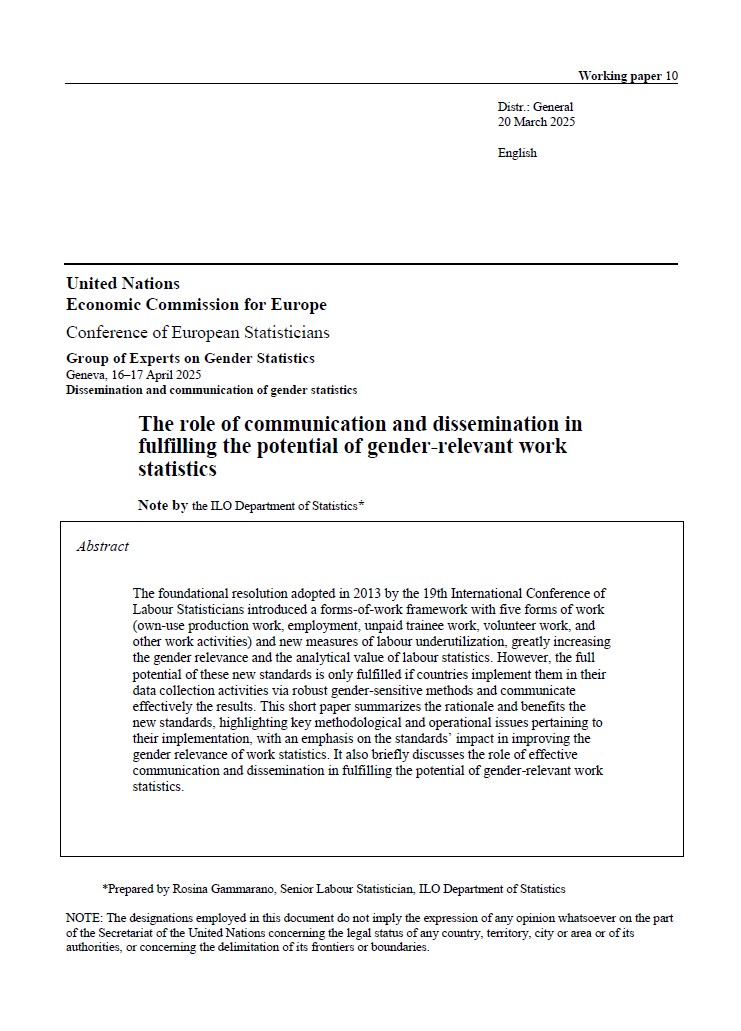Technical working groups
Technical Working Groups (TWGs) support the development and implementation of international statistical standards. This page presents the active TWGs and their main work.
Technical working groups Read More »
Technical Working Groups (TWGs) support the development and implementation of international statistical standards. This page presents the active TWGs and their main work.
Technical working groups Read More »

While dependent contractors have long existed as a group of workers, they have only been made visible in official statistics recently.

On World Food Safety Day, the ILO analyzes the work of subsistence foodstuff producers, as per improved international statistical standards.
Subsistence foodstuff producers: the importance of making their work visible Read More »

The foundational resolution adopted in 2013 by the 19th International Conference of Labour Statisticians introduced a forms-of-work framework with five forms of work (own-use production work, employment, unpaid trainee work, volunteer work, and other work activities) and new measures of labour underutilization, greatly increasing the gender relevance and the analytical value of labour statistics. However, the full potential of these new standards is only fulfilled if countries implement them in their data collection activities via robust gender-sensitive methods and communicate effectively the results. This short paper summarizes the rationale and benefits the new standards, highlighting key methodological and operational issues pertaining to their implementation, with an emphasis on the standards’ impact in improving the gender relevance of work statistics. It also briefly discusses the role of effective communication and dissemination in fulfilling the potential of gender-relevant work statistics.

This interactive visualization tool shows the impact of the latest statistical standards across a range of work-related topics, highlighting the increased analytical value of statistics.
Visualization tool on the impact of latest statistical standards Read More »

This checklist provides a simple way of verifying that all conditions required to consider the standards adopted by the 19th International Conference of Labour Statisticians (ICLS) as fully applied in a given data collection activity are met.
Checklist for 19th ICLS standards application Read More »

A crucial aspect of the implementation of latest labour statistics standards is the effective communication of the results, to ensure getting the best out of the data. This guide aims to provide practical data visualization examples to convey clearly and intuitively the impact of methodological changes on key labour indicators following the implementation of the 19th ICLS resolution and avoid misinterpretation of the results.
Labour force surveys (LFS) are the main source for many key indicators of the labour market and the world of work. To support countries in conducting their national LFS in line with international standards, the ILO Department of Statistics developed an LFS toolkit which features a model survey questionnaire, a national adaptation guide, a variable derivation guide, a syntax sample, and many more resources. Discover the ILO LFS toolkit with this video, and check its contents in its page: https://ilostat.ilo.org/resources/lfs.
ILO Labour Force Survey toolkit Read More »
Most employed people around the world are in the informal economy, which increases people’s vulnerability and puts national economies at risk. Through new statistical standards on the informal economy and improved data collection tools and methods, the ILO helps countries improve their measurement of informal employment to better understand the working lives and conditions of people with informal jobs.
New statistical standards for improved measurement of the informal economy Read More »